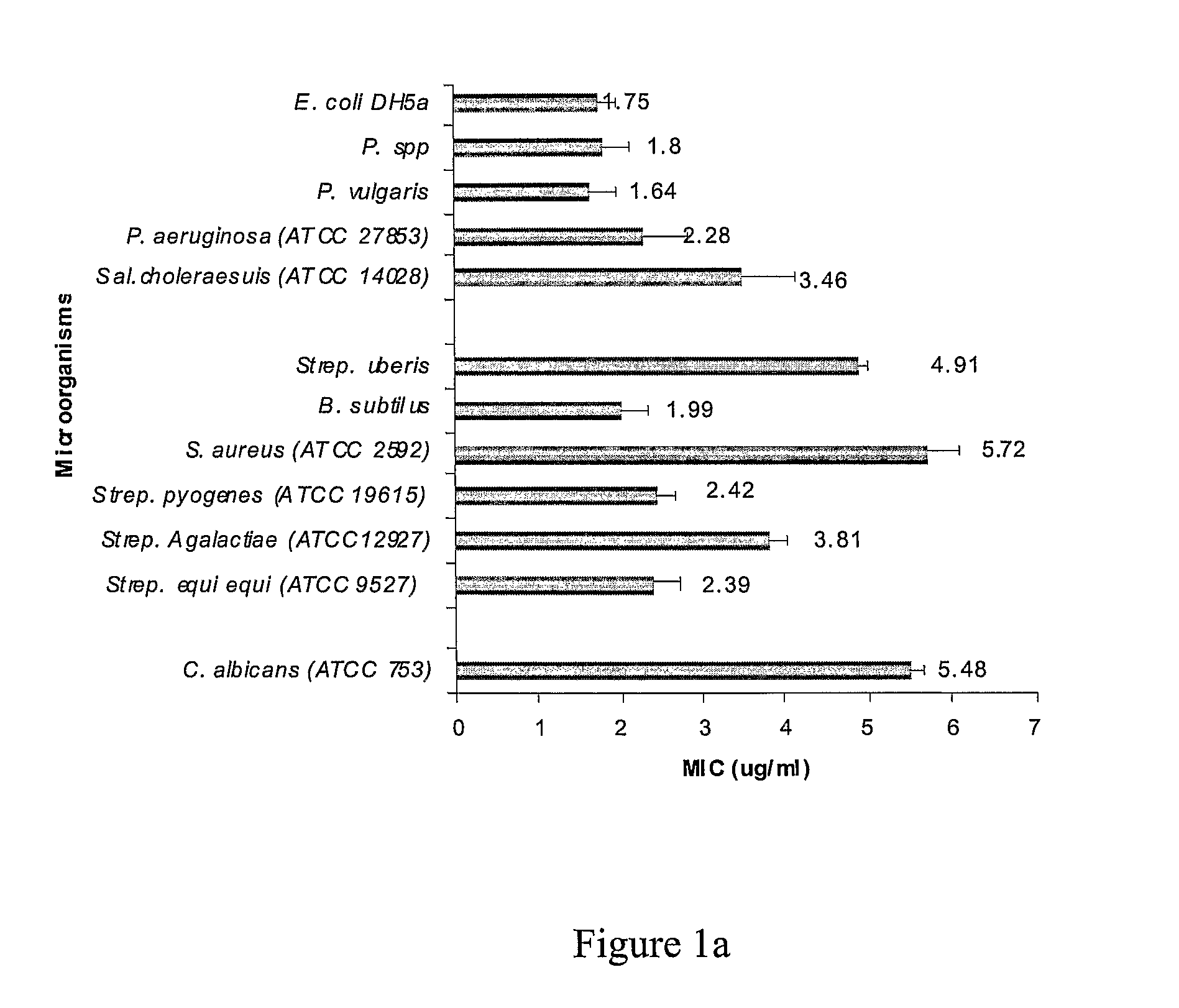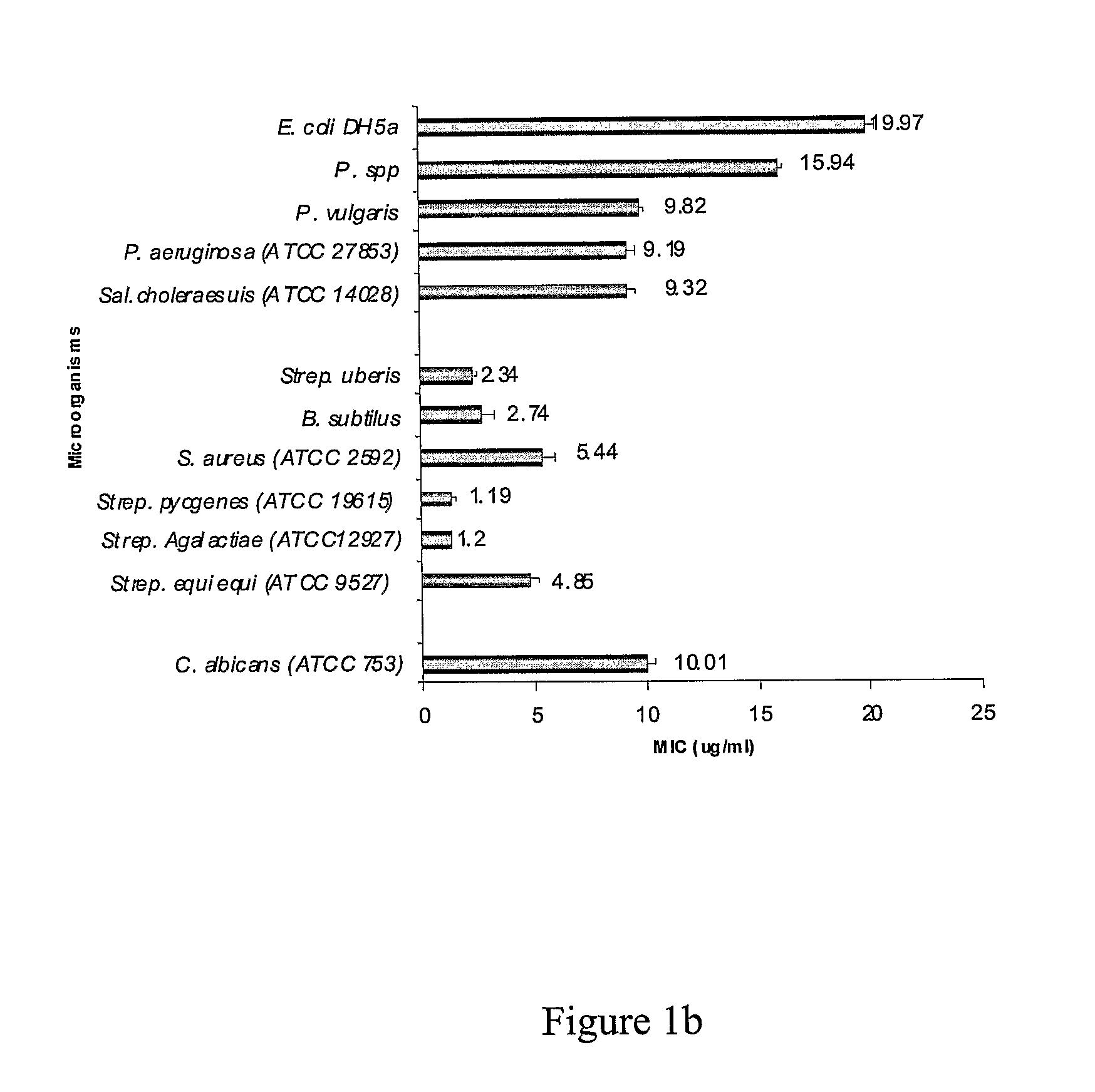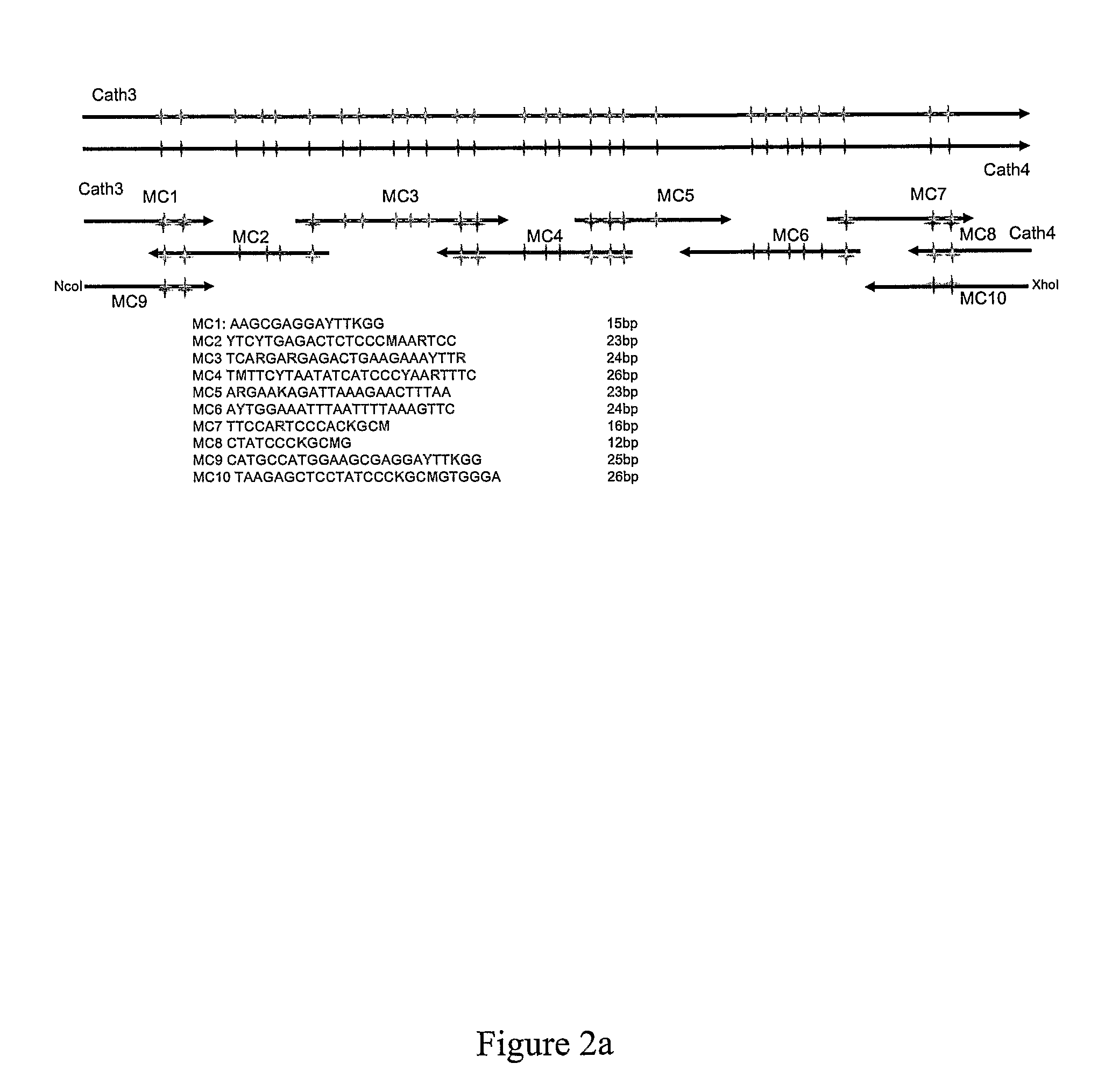Method of treatment using antimicrobial composition
a technology of composition and antimicrobial composition, which is applied in the direction of peptide/protein ingredients, depsipeptides, and vectors, etc., can solve the problems of limiting the utility of mammals as bioreactors for producing pharmaceutical agents, exacerbating the adverse effects of infection, and reducing the efficiency of antibiotic production. the effect of growth
- Summary
- Abstract
- Description
- Claims
- Application Information
AI Technical Summary
Benefits of technology
Problems solved by technology
Method used
Image
Examples
example 1
Peptides Having Antimicrobial Activity Against a Variety of Microorganisms Including Mastitis Causing Microorganisms
[0354]This example demonstrates the antimicrobial profile of synthetic peptides designated AGG01 (SEQ ID NO: 7) and AGG02 (SEQ ID NO: 8) against agents of mastitis.
Synthetic Peptides
[0355]Two amidated peptides were commercially synthesized by Auspep. The sequences of the peptides are as follows:
(SEQ ID NO: 7)KRGFGKKLRKRLKKFRNSIKKRLKNFNVVIPIPLP-NH2;and(SEQ ID NO: 8)KRGLWESLKRKATKLGDDIRNTLRNFKIKFPVPRQ-NH2.
Antimicrobial Assays
[0356]Peptides were tested for antimicrobial activity against Streptococcus uberis, Escherichia coli DH5α, Escherichia coli DH5α comprising an ampicillin resistant gene, Pseudomonas spp., Pseudomonas vulgaris, Proteus vulgaris, Pseudomonas aeruginosa (ATCC 27853), Salmonella choleraesuis (ATCC 14028), Bacillus subtilis, Staphylococcus aureus (ATCC 25923), Streptococcus pyogenes (ATCC 19615), Streptococcus Agalactiae (ATCC 12927), Streptococcus equi e...
example 2
Production Of Additional Antimicrobial Peptides by Mutagenesis
[0362]This example demonstrates the production of new synthetic antimicrobial peptides by evolution of antimicrobial peptides of the invention and C-termini of cathelicidin proteins.
Peptide Synthesis
[0363]Several mutagenesis approaches were employed to generate peptides having antimicrobial activity based on the sequences of peptides comprising SEQ ID NO: 7 and / or 8.
[0364]In a first process, the nucleotide sequences of nucleic acids encoding SEQ ID Nos: 7 and 8 were aligned, and codons encoding variable amino acids identified. A nucleotide sequence was then determined that was capable of encoding a sequence comprising an amino acid at any position that occurs in either SEQ ID NO: 7 or SEQ ID NO: 8. This consensus nucleotide sequence is set forth in SEQ ID NO: 88. Synthetic nucleic acids comprising possible sequences conforming to the sequence set forth in SEQ ID NO: 88 were then synthesized by PCR using degenerate olignon...
example 3
Stability of Antimicrobial Peptides in Milk
[0374]This example demonstrates the resistance of the bioactive synthetic antimicrobial peptide designated AGG01 (SEQ ID NO: 7) to proteolysis by milk proteases, thereby showing utility of the peptide in mammary glands or secretions thereof before or during or after lactation, or as a milk additive.
[0375]To determine whether or not antimicrobial peptides are bioactive in milk peptides comprising a sequence set forth in SEQ ID NO: 7 or SEQ ID NO: 8 were diluted in either 10 mM phosphate buffer or fresh or pasteurized milk to a final concentration of 200 μg / ml. Treatment groups are shown in Table 2.
TABLE 2Peptide23451Fresh milkPasteurized milk6SEQ IDIn sodium37° C., 30 min37° C., 60 min37° C., 30 min37° C., 60 minMilk onlyNO: 7phosphate buffer,(fresh)4° C., 1 hourSEQ IDIn sodium37° C., 30 min37° C., 60 min37° C., 30 min37° C., 60 minMilk onlyNO: 8phosphate buffer,(pasteurized)4° C., 1 hour
[0376]Peptides having or comprising sequences set fort...
PUM
| Property | Measurement | Unit |
|---|---|---|
| Temperature | aaaaa | aaaaa |
| Temperature | aaaaa | aaaaa |
| Temperature | aaaaa | aaaaa |
Abstract
Description
Claims
Application Information
 Login to View More
Login to View More - R&D
- Intellectual Property
- Life Sciences
- Materials
- Tech Scout
- Unparalleled Data Quality
- Higher Quality Content
- 60% Fewer Hallucinations
Browse by: Latest US Patents, China's latest patents, Technical Efficacy Thesaurus, Application Domain, Technology Topic, Popular Technical Reports.
© 2025 PatSnap. All rights reserved.Legal|Privacy policy|Modern Slavery Act Transparency Statement|Sitemap|About US| Contact US: help@patsnap.com



